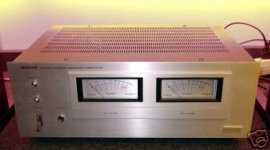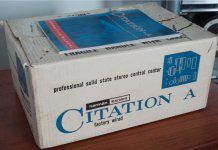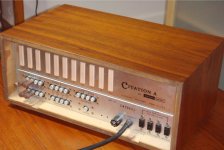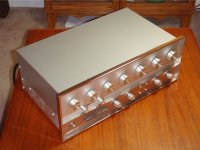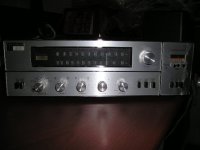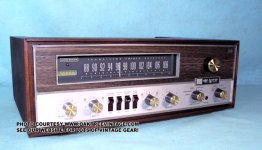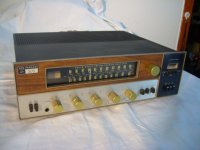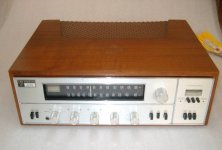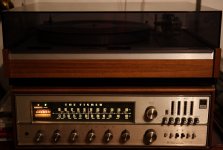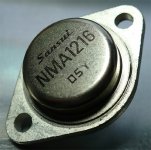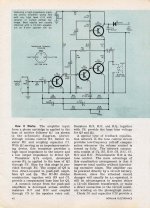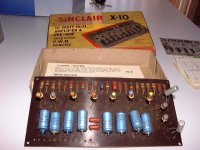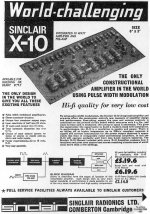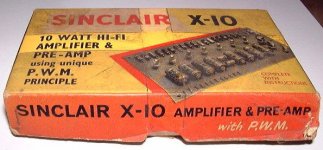Yes, but this is a more advanced design, originally done by Dick Burwen, then of Analog Devices, and then Sid Smith at Marantz, in the mid to late '60's, fully 10 years ahead of Hitachi.
I recall, the HMA7500 was over a long time (at least 2-3 years - from 1978 - 1981, I think) the reference power amp of German's hifi magazine "Audio". The first power amps from Hitachi where 2SJ/2SK lateral MOSFETs inside.Already done in 1978 and 1979 by Hitachi, in their first power amplifiers demonstrating the advantages of their 2SJ/2SK lateral MOSFETs. Note the use of the current mirror as collector load for the VAS. That's an elegant evolution from Locanthi's January 1967 schematic. Audio-grade opamps like NE5534 and OPA134 have the same structure. Was Locanthi the originator, in January 1967, of such twin differential arrangement ?
Attachments
Can you point link, so I can have a look to those very interesting & historic schematics ?Yes, but this is a more advanced design, originally done by Dick Burwen, then of Analog Devices, and then Sid Smith at Marantz, in the mid to late '60's, fully 10 years ahead of Hitachi.
interesting to see the Hitachi power mplifier i was at the launch of this exciting new product I also have 1 in my collection
regards Trev
regards Trev
While not a power amplifier take a look at the HK Citation A pre-amplifier which uses a bunch of complementary unity gain buffers at various points in the design. This design dates from the early 1960s (About 1963) and was one of Harman Kardon's first solid state products.
The gain stages are all compound complementary types. Everything is built on little cards despite which are somewhat inconvenient to work on. This is a very interesting early solid state design by Stewart Hegeman. I have worked on a number of them, and was quite surprised at how good it sounds compared to a number of other vintage solid state pre-amps. A lot of the magic unfortunately does appear to be the germanium transistors used, and I came up with a mod in the early 1990s to convert these to silicon. (Basically a complete redesign.) Later on I decided to try and replace only the bad germanium transistors which proved difficult but not impossible to source at the time.
Oddly I have not found much on line about this model. My schematics are buried in files that now live in the garage - maybe soon to find a place in the house.
The gain stages are all compound complementary types. Everything is built on little cards despite which are somewhat inconvenient to work on. This is a very interesting early solid state design by Stewart Hegeman. I have worked on a number of them, and was quite surprised at how good it sounds compared to a number of other vintage solid state pre-amps. A lot of the magic unfortunately does appear to be the germanium transistors used, and I came up with a mod in the early 1990s to convert these to silicon. (Basically a complete redesign.) Later on I decided to try and replace only the bad germanium transistors which proved difficult but not impossible to source at the time.
Oddly I have not found much on line about this model. My schematics are buried in files that now live in the garage - maybe soon to find a place in the house.
Last edited:
very interesting. have a look to Ebay Item number: 150434801318. Because the pics are deletet from ebay after a while, I transfered the pics. Elsewhere on the web I don't find inside pics from Citation A.While not a power amplifier take a look at the HK Citation A pre-amplifier which uses a bunch of complementary unity gain buffers at various points in the design. This design dates from the early 1960s (About 1963) and was one of Harman Kardon's first solid state products.
The gain stages are all compound complementary types. Everything is built on little cards despite which are somewhat inconvenient to work on. This is a very interesting early solid state design by Stewart Hegeman. I have worked on a number of them, and was quite surprised at how good it sounds compared to a number of other vintage solid state pre-amps. A lot of the magic unfortunately does appear to be the germanium transistors used, and I came up with a mod in the early 1990s to convert these to silicon. (Basically a complete redesign.) Later on I decided to try and replace only the bad germanium transistors which proved difficult but not impossible to source at the time.
Oddly I have not found much on line about this model. My schematics are buried in files that now live in the garage - maybe soon to find a place in the house.
Attachments
-
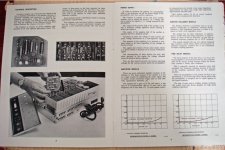 Harman Citation A page 3+4 Serv.Man.jpg172 KB · Views: 591
Harman Citation A page 3+4 Serv.Man.jpg172 KB · Views: 591 -
Harm. Citation A advertisement 1962.pdf46 KB · Views: 169
-
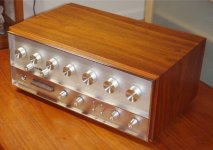 Harm. Citation A front.jpg147 KB · Views: 566
Harm. Citation A front.jpg147 KB · Views: 566 -
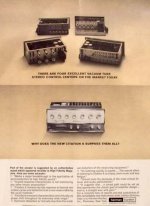 Harman Citation A advertsement.jpg72.6 KB · Views: 551
Harman Citation A advertsement.jpg72.6 KB · Views: 551 -
Harman Citation A Owner's Manual.pdf62.1 KB · Views: 179
-
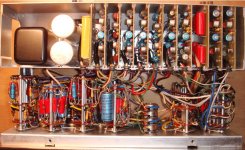 Harman Citation A inside top.jpg222.6 KB · Views: 275
Harman Citation A inside top.jpg222.6 KB · Views: 275 -
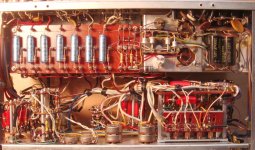 Harman Citation A inside botton.jpg212.8 KB · Views: 258
Harman Citation A inside botton.jpg212.8 KB · Views: 258
Last edited:
Citation A pre-amplifier
Citation A pre-amplifier more pics
for me was new, that already in 1962/1963 in the United States such amps exist in solid state version.
Most brands in Europe uses tubes and rarely germanium transistor devices from the AD/AL/ALZ series, mostly by low to medium output power.
What model was the associated power amplifier to this Citation-A? Was it also already a solid state version (perhaps with RCA's 2N3055 resp. Harman's specific factory number?
Perhaps one can post complete schematic of both
Citation A pre-amplifier more pics
for me was new, that already in 1962/1963 in the United States such amps exist in solid state version.
Most brands in Europe uses tubes and rarely germanium transistor devices from the AD/AL/ALZ series, mostly by low to medium output power.
What model was the associated power amplifier to this Citation-A? Was it also already a solid state version (perhaps with RCA's 2N3055 resp. Harman's specific factory number?
Perhaps one can post complete schematic of both
Attachments
Last edited:
I seem to remember working on a few old (at the time) Fisher receivers, in the early 70's, having complimentary power transistors in the outputs. Blew up a lot a I recall, and hard to fix, I think the outputs were germanium and expensive. Thought it was a model '500' or something like that, but the only solid state Fisher '500' receiver I could find mention of on the net is the 500T (1962) but no mention of complimentary outputs.
I seem to remember working on a few old (at the time) Fisher receivers, in the early 70's, having complimentary power transistors in the outputs. Blew up a lot a I recall, and hard to fix, I think the outputs were germanium and expensive. Thought it was a model '500' or something like that, but the only solid state Fisher '500' receiver I could find mention of on the net is the 500T (1962) but no mention of complimentary outputs.
In my own "505" exemplare follow power transistors in use:
Sansui NMA1216 and NMC1216 in the TO-3 outline. and in that exemplare of one of the pics devices from Motorola.
Also an interesting and fine-looking receiver series.
Here some URLs and pics
http://cyfa.co.kr/bbs/board.php?bo_...&sfl=&stx=&sst=wr_hit&sod=asc&sop=and&page=66
http://www.hifi-studio.de/hifi-klassiker/fisher/Fisher_450T/fisher_450T.htm
http://www.mikesmanuals.com/Upload/...Service_Manual_for_Serial_no_10001_and_UP.jpg
Attachments
Last edited:
The mentioned transistor models NMA1216 and NMC1216 in the TO-3 outline are also inside by Sansui's AU919
BA-F1 Questions - AudioKarma.org Home Audio Stereo Discussion Forums
BA-F1 Questions - AudioKarma.org Home Audio Stereo Discussion Forums
Attachments
GE's first true complementary power devices from 4-16 or the 16th week of 1954
Transistor
and
http://transistorhistory.50webs.com/
there are also a wide range of pics, also about very old true complementary pairs from various brands like Sylvania.
now the next step we can start:
finding out the first commercial true complementary Class-AB power amp.
The formerly employees of the companies RCA, Sylvania, Raytheon, GE, and TI should actually know yet to which audio amplifier manufacturers they sold the first released devices. Mr. John Curl and Nelson Pass knows certainly a lot of them, maybe also Mr. Bob McGarrah, the author of the mentioned URL.
I have found an interesting source of informations; read this informations about the URLThog is asking about amplifiers not devices.
Transistor
and
http://transistorhistory.50webs.com/
there are also a wide range of pics, also about very old true complementary pairs from various brands like Sylvania.
now the next step we can start:
finding out the first commercial true complementary Class-AB power amp.
The formerly employees of the companies RCA, Sylvania, Raytheon, GE, and TI should actually know yet to which audio amplifier manufacturers they sold the first released devices. Mr. John Curl and Nelson Pass knows certainly a lot of them, maybe also Mr. Bob McGarrah, the author of the mentioned URL.
Last edited:
Cool stuff,
I've seen quite a few Raytheon, Sylvania and GE transistors from this era..
Westinghouse also made a big PNP germanium transistor that was used in power supplies sometime in the late 1950s to early 1960s. I had such a supply made I think by Lambda or similar - it had a lot of them in modules which were basically tubular channel heatsinks mounted on octal sockets. (Forced air cooling) The thing had at least 9 of them in parallel, IIRC. (2A 60V supply)
I've seen quite a few Raytheon, Sylvania and GE transistors from this era..
Westinghouse also made a big PNP germanium transistor that was used in power supplies sometime in the late 1950s to early 1960s. I had such a supply made I think by Lambda or similar - it had a lot of them in modules which were basically tubular channel heatsinks mounted on octal sockets. (Forced air cooling) The thing had at least 9 of them in parallel, IIRC. (2A 60V supply)
to find out the first solid state audio amplifier device in general I have start this thread today:
http://www.diyaudio.com/forums/soli...id-state-audio-amplifier-components-want.html
but the really first amp, where the first true-complementary pair is in use, is also still wanted.
http://www.diyaudio.com/forums/soli...id-state-audio-amplifier-components-want.html
but the really first amp, where the first true-complementary pair is in use, is also still wanted.
Last edited:
The SWTPC amp from the attachement mentioned true complementary stage.
check also out this URL
SWTPC Catalog - Circa 1978
But when was this model introduced ??
And from where I can download schematics ?
And here a diy concept from 1966:
Popular Electronics Magazine, September 1966
check also out this URL
SWTPC Catalog - Circa 1978
But when was this model introduced ??
And from where I can download schematics ?
And here a diy concept from 1966:
Popular Electronics Magazine, September 1966
Attachments
Last edited:
lowe opta lord
Interesting ... I've got a radio sitting in a box somewhere made supposedly by Bush (UK) which is, apart from a wood laminate exterior, is IDENTICAL to this one! Now which box is that in???? 🙂
Interesting ... I've got a radio sitting in a box somewhere made supposedly by Bush (UK) which is, apart from a wood laminate exterior, is IDENTICAL to this one! Now which box is that in???? 🙂
Perhaps you can find out this there:
The Vintage Bush Radio website
Bush history
Bush 1950s & 1960s Radios from Bush Radio
http://textualcreations.ca/Bush Radio Top signed_1200.jpg
museum of vintage radios. Bush DAC 30 valve radio. KB FB 10 toaser radio. PYE Radio Model P224. Old tube radios
Back to the actually subject "first Complementary AB bipolar amp":
the first true complementary "high power" silicon pair from USA must actually be Motorola's MJ802/MJ4502. Some of the power amp stages from "Southwest Technical Products Corporation" are equipped with this type:
http://www.swtpc.com/mholley/Catalog/Catalog.htm
http://www.swtpc.com/mholley/Catalog6/Catalog.htm
http://www.swtpc.com/mholley/Catalog1975b/Catalog1975b.htm
http://www.swtpc.com/mholley/Catalog1973b/Catalog.htm
http://www.swtpc.com/mholley/Catalog1972a/Catalog1972a.htm
http://www.swtpc.com/mholley/Catalog1971a/Catalog1971a.htm
http://www.swtpc.com/mholley/Catalog1970/Catalog1970.htm
http://www.swtpc.com/mholley/Catalog1969a/Catalog1969a.htm
http://www.swtpc.com/mholley/Catalog1968/Catalog1968.htm
http://baselaudiolab.com/TIGER-01-207B.pdf
http://www.diyaudio.com/forums/solid-state/150684-swtpc-tiger-01-207b-schematic.html
http://www.diyaudio.com/forums/solid-state/92036-1971-plastic-tiger.html
http://www.diyaudio.com/forums/solid-state/92036-1971-plastic-tiger.html
http://www.diyaudio.com/forums/solid-state/3929-sound-quality-different-transistors-4.html
Last edited:
Tief, you are ignoring the history of Motorola presented to you. We had been making power amps with complementary POWER TRANSISTORS for fully 5 years with Motorola parts, BEFORE 1981. Southwest Technical was a forward thinking corporation, much like Sinclair was in GB, in 1965, or so, with its Class D amplifier. Anybody remember that one? However, like Sinclair, follow through was not there and problems developed.
To give credit, SWTP was the first manufacturer to advertise the complementary differential input stage in 1972. They developed it independently, but both Jon Iverson and I had developed it about 5 years before-hand. We just did not publish it.
To give credit, SWTP was the first manufacturer to advertise the complementary differential input stage in 1972. They developed it independently, but both Jon Iverson and I had developed it about 5 years before-hand. We just did not publish it.
post #52 - I was exposed to the 2N3716-2N3792 combination in 1966, while working at Friden, by the Motorola Reps. over lunch, provided by them. The next generation of Motorola devices came from a similar device pair, called the 2N5031 and the 2N6031. This was the basis of the later amps, like SAE and Ampzilla. The 2N5884 and 2N5886 was my personal choice between 1970-1975. This was only an 80V part, but had better safe area than the 2N3716-2N3792. The 2N5684-2N5686 combination was available in 1969 and had 300W dissipation in each device and 50A capability, BUT the safe area was less than the 2N5884-6 combination and therefore had to be more carefully utilized to prevent 2'nd breakdown.
Tief, you are ignoring the history of Motorola presented to you. We had been making power amps with complementary POWER TRANSISTORS for fully 5 years with Motorola parts, BEFORE 1981. Southwest Technical was a forward thinking corporation, much like Sinclair was in GB, in 1965, or so, with its Class D amplifier. Anybody remember that one? However, like Sinclair, follow through was not there and problems developed.
To give credit, SWTP was the first manufacturer to advertise the complementary differential input stage in 1972. They developed it independently, but both Jon Iverson and I had developed it about 5 years before-hand. We just did not publish it.
Sorry, I have overlooked your post #52
the predecessors of MJ802/4502 were only slightly weaker than the MJ802/4502 itself:
2N3716-2N3792 80V/10A/150W 4MHz
2N5631 and the 2N6031 140V/16A (20)/200W 1MHz
2N5884 and 2N5886 80V/25(50)A/200W 4MHz
MJ802/MJ4502 90V/30A/200W 2MHz
BTW - You have a lot of contacts to Motorola's former employees. I want to have the very interest Motorola article from Mr. R. Lender
"Power Amplifier with darlingon output stage"
Motorola Inc., Geneva, Switzerland,
7.9.1974 internal report (July 9. or Sep. 7 - I don't know)
To find this, I start this thread:
http://www.diyaudio.com/forums/soli...age-large-voltage-swings-lenders-circuit.html
Perhaps you know more - thank you very much.
P.S. Mean you the class-D amp "X-10" from the attachement?
Planet Sinclair: Audio: Amplifiers: X-10
Attachments
throw in my 2 cents. Both the Marantz 15 and the JBL SE400 date back to 1966. Google searches have found reviews for both in 1966. The main problem, as mentioned by others, was lack of high quality PNP silicon devices for reasonable cost. Similar problems before then for high quality NPN germanium devices. I'm pretty sure that these were before the SWTP amps. I don't know of any other consumer products before that time, however there may also be professional equipment out there.
- Home
- Amplifiers
- Solid State
- What was the first Complementary AB bipolar amplifiers?
